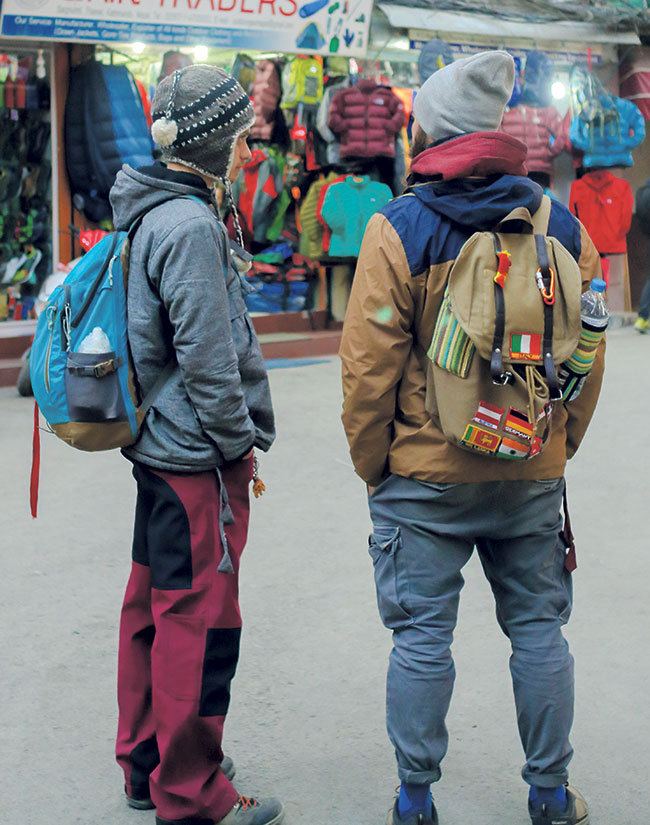As the mercury across the country is plummeting with each passing day, the minimum temperature in Kathmandu was recorded at around zero degree Celsius on Sunday. But the bone biting cold does not keep Kathmanduiets from getting out and about. As a result, people can be seen wearing bulky and fluffy clothes, eating hot food and sitting near bonfires to keep themselves warm.
The wind is chilling at this time of the year, so the smart thing to do is to wear gears cap keep you warm from the inside and cheats the wind on the outside. Among many other winter attires cap are considered as favorites, woolen caps are one of the winter gears designed to avoid winter iciness. Woolen caps are available in a variety of patterns, some of which are specific to certain brands, while others come with generic designs. Funny caps, beanie caps, ear fluff caps and round caps, among others are some examples of contemporary woolen caps.
“Pelage Exporters Pvt Ltd has been involved in producing woolen products in Nepal for more than 20 years now. We are the manufacturer, wholesaler, retailer and exporter of woolen products,” said Udhav Bhetuwal, staff of Pelage Exporters Pvt Ltd, Thamel. Talking about his customers’ favorites, Bhetuwal said youngsters mostly preferred designs with a quirky edge whereas adults chose durable and traditional woolen hats. “This year, we’ve been selling more than 20 caps a day ever since winter arrived,” he added.
According to Bhetuwal, woolen funny caps are knitted caps made in shapes of different animals, while beanie woolen caps have a bobble or pom-pom on the top. Similarly, ear fluff caps have woolen fluffs that cover your ears. Bhetuwal said all the wool was imported from New Zealand and the products are exported to as far as Australia, Russia and Portugal. The woolen caps cost between Rs 300 to Rs 650 and come in three sizes: adult, baby and child.
Likewise, Raja Ram Khadka, a staffer at Thamel-based Sandeep Enterprise, said, “Especially, foreigners prefer hand-made knitted woolen caps. But the selling rate of woolen caps has gone sharply down after the 2015 earthquakes. While international tourists prefer pure woolen caps, Nepalis favor fabrics made of acrylic material.
Men’s F/W 2018-19 trends

Creative Mines International Woolen Handicraft and Cotton, a manufacturer, wholesaler and exporter located at Satghumti, Thamel, also sells different handmade woolen caps. They manufacture all their products at their own factory in Banepa, Kavre, and import the polar flees from Singapore and China.
Bodha Raj Bhandari, 50, a tourism businessperson who was spotted at Creative Mines, said, “I have short hair and the winter air is chilling, so I came here to buy some woolen caps. I am thinking of buying simple round caps because I am used to with the design and they feel comfortable.”
Myths and tips about dressing for winter
 Do you know enough about the cold to keep warm?
Do you know enough about the cold to keep warm?
Poor planning of a winter outing can lead to frostbite and hypothermia. The following are some misconceptions about the cold and suggestions for staying toasty this winter.
Myth: Dressing warmly avoids colds, viruses, and flu.
Mom was wrong on this one — mostly. If you haven't been exposed to a virus, cold weather won't make any difference. There are over 200 viruses that can cause the common cold.
Myth: You lose body heat through your head.
There's nothing special about your head. You'll lose body heat from any part of your body that is exposed. It's a good idea to wear a hat, but other parts of your body must also be covered to keep you from getting cold, experts say.
The amount of heat you can lose through your head depends on a number of factors, including how thick your hair is and how much energy you use in the cold. The ratio of the surface area of a child's head relative to the child's body surface area is much greater than that of an adult. Children lose proportionally more heat through their heads. Hoods and hats are more important to children because of this.
Myth: Men and women feel cold at the same temperature.
Ever notice that women's hands and feet tend to get colder before men's? It's because the external temperature at which men’s and women's bodies begin conserving heat — called the set point temperature — varies by about 3°.
When surrounding temperatures drop to a certain point, your body will conserve heat by shutting off the blood flow to the hands and feet, making them feel chilled. For women, that temperature is about 70°, while men can hold steady until about 67° or 68°.
Myth: Dress in layers to stay warm.
It's true that dressing in layers allows people to adjust for different levels of activity. But one warm garment that is well-made will do just as well to keep away the winter chills.
Dressing in layers does make sense, particularly for someone exercising in the cold. For the best results, wear polypropylene or another man-made fabric next to the skin, a knit middle layer (which can be taken off if you get too warm), and a man-made outer layer.
Myth: Drinking alcohol will keep you warm.
Drinking alcohol may make you feel warm because it causes blood to rush to your skin's surface. But it actually causes your blood vessels to widen and makes you lose heat faster. Drinking alcohol in the cold also decreases the shivering process, which produces extra body heat.
But the worst part about alcohol consumption is that it impairs judgment. Winter cold can be dangerous if you are not ready, or if you have prepared by following false information. Prepare now by educating yourself about the safest ways to protect yourself when the cold arrives.
(Source: rochester.edu)



































